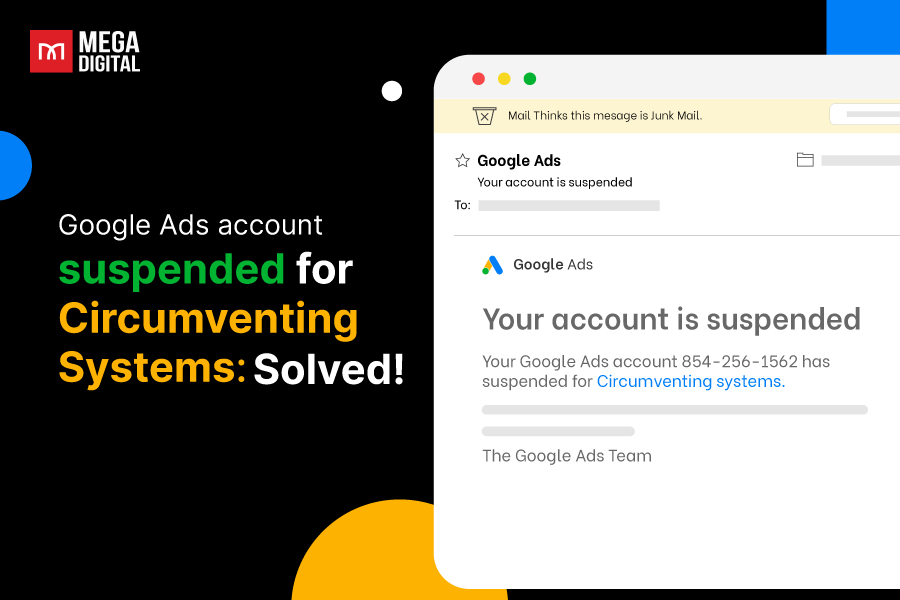Monitoring ad campaigns manually is time-consuming and can lead to overspending. To address this issue, Facebook has launched its new Facebook Automated Rules feature. In this article, Mega Digital will guide you through the ins and outs of Facebook ads automated rules, providing best practices and examples to help you get the most out of this tool.
What are Facebook Automated Rules?
Facebook ads automated rules are customizable settings that let advertisers automate certain actions on their campaigns, ad sets, and ads.
These rules can be set to run at specific times or in response to particular conditions, helping you:
- Optimize performance
- Manage budgets
- Ensure ads stay aligned with marketing goals.
Benefits of Automated Rules Facebook Ads
Before exploring how to use this feature, let’s learn about the benefits that this tool brings to you.
Time-Saving

One of the most significant benefits of using Facebook’s automated rules is the time you save by reducing manual monitoring and adjustments. For example, if you set a rule to pause ads that have a high cost per click (CPC), you don’t have to check and adjust your campaigns constantly. Instead, the automated rule will handle it, allowing you to focus on other strategic tasks.
Consistency

Automated rules ensure that your campaigns are consistently managed according to your predefined criteria.
A case study from AdEspresso found that advertisers, who used automated rules to manage their budgets and bids saw more consistent performance across their campaigns, compared to those who relied solely on manual adjustments. The automated rules helped maintain a steady cost per acquisition (CPA) by automatically adjusting bids based on performance metrics.
Enhanced Budget Management
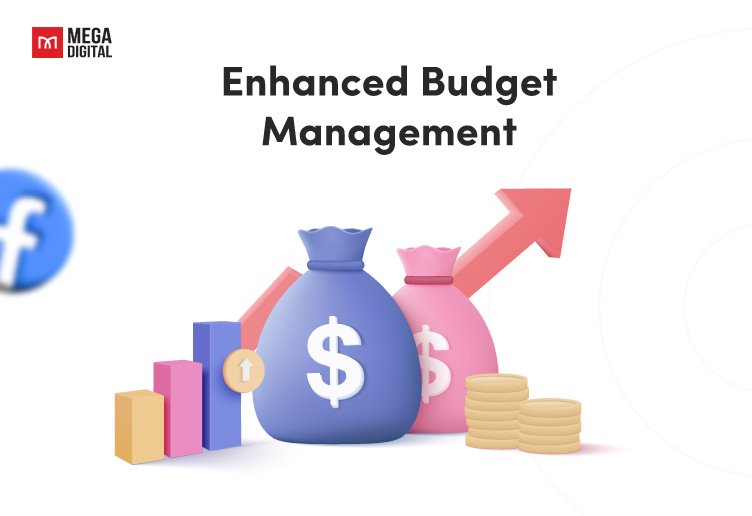
Automated rules help you manage your budget more effectively by reallocating resources based on performance. The computerized rules allowed for real-time budget adjustments, ensuring that high-performing ads received more funding while underperforming ads were scaled back.
Improved Performance Optimization

With automated rules, you can set criteria for performance optimization, such as pausing low-performing ads or increasing bids for high-performing ones. This approach ensures that your campaigns are continually optimized for the best possible results.
6 Types of Automated Rules for Facebook
Understanding all types of automated rules Facebook provides, you can set up rules that best suit your advertising goals. Here are the main types of automated rules you should consider and remember:
1. Budget Rules
Budget rules allow you to automatically adjust your campaign or ad set budget based on specific performance metrics. These adjustments can either increase or decrease the budget according to predefined conditions.
You should use budget rules when you want to allocate your ad spend to maximize efficiency and ROI dynamically. This is particularly useful for scaling high-performing campaigns or controlling costs on underperforming ones.
>>> Read more: Facebook Ad Budget: How to Calculate and Optimize Ad Budget?
Example: You have a campaign that consistently performs well with a high Return on Ad Spend (ROAS). To capitalize on its success, you set a rule to increase its budget by 10% whenever the ROAS exceeds 4 with the automated rule “Increase daily budget by 10% if ROAS > 4.” This ensures that more resources are directed towards high-performing ads, maximizing your returns.
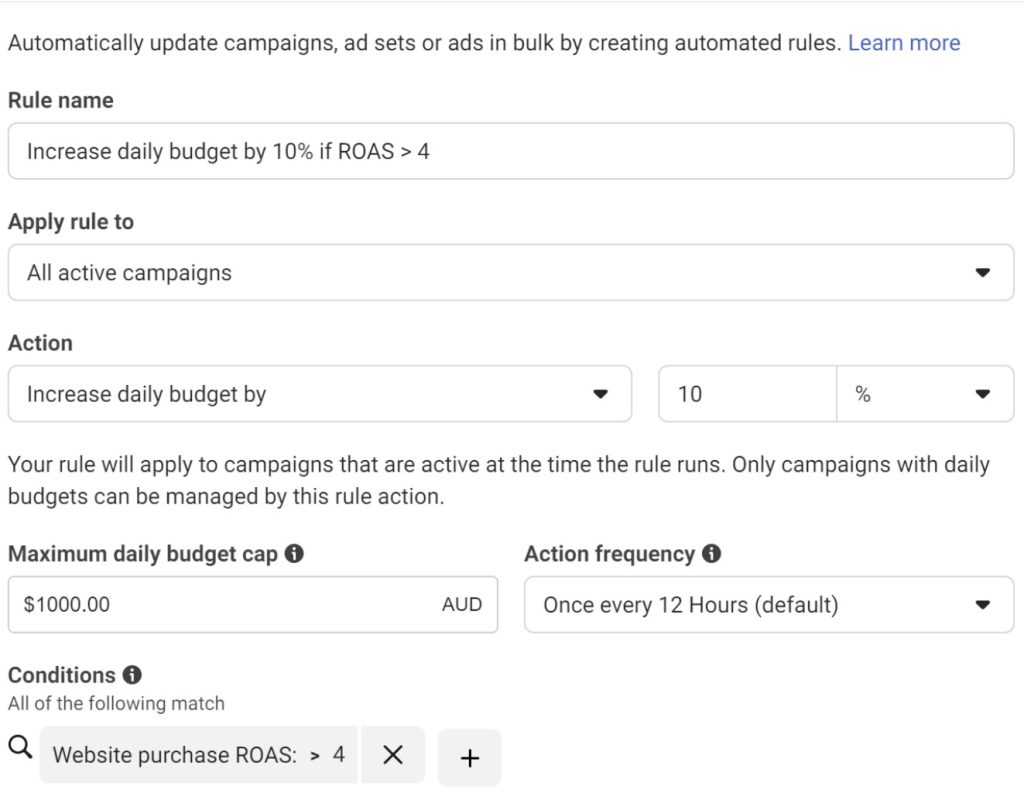
2. Bid Rules
Bid rules let you automatically adjust your bids in ad auctions. This helps you manage your bids effectively, ensuring you don’t pay too much for each click or conversion. It’s particularly helpful in competitive ad markets.
>>> Read more: Choose the Right Facebook Bidding Strategy to Outbid Competitors
Example: If the Cost Per Click (CPC) for your ad rises above $2, you might want to reduce your bid by 5% to control costs and maintain efficiency. So, you can choose the rule like “Decrease bid by 5% if CPC > $2.“
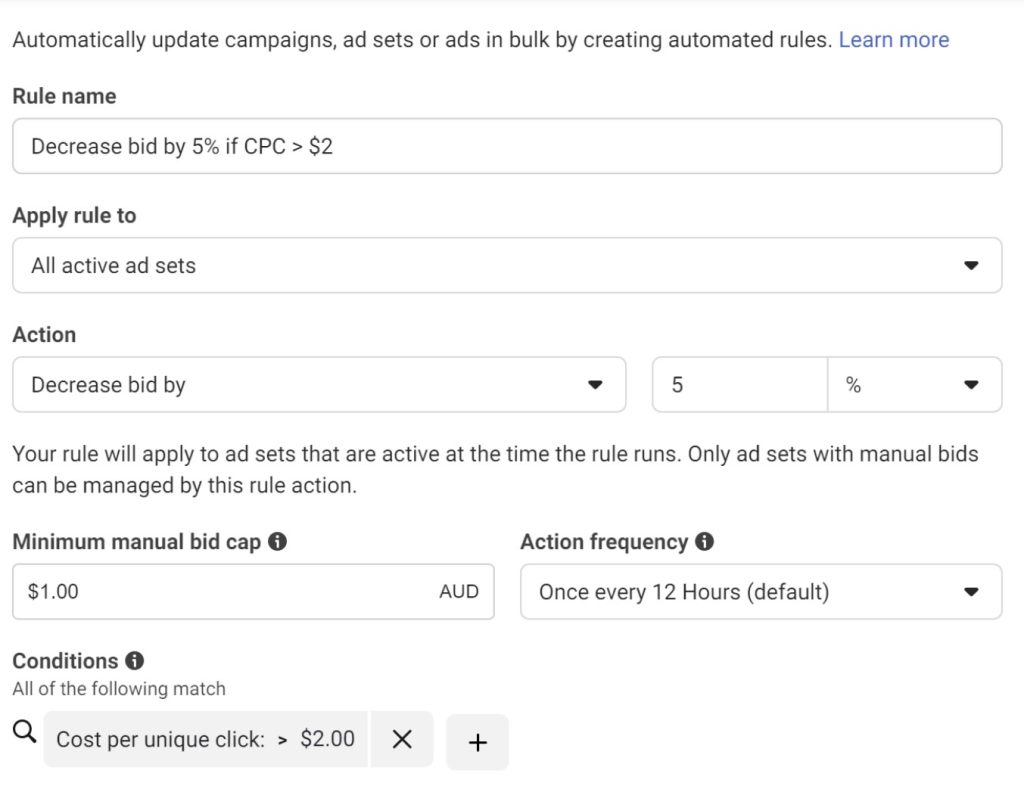
3. Schedule Rules
Schedule rules allow you to turn your ads on or off at specific times or under certain conditions, ensuring they run at the most effective times. When your ads are active, you can use this rule if you want to manage them during peak hours for better engagement or pause them during off-hours to save budget.
Example: If your ads don’t perform well at night, you can set a rule to pause them from 10 PM to 6 AM – with the rule “Pause ads from 10 PM to 6 AM”, ensuring your budget is spent when it’s most effective.
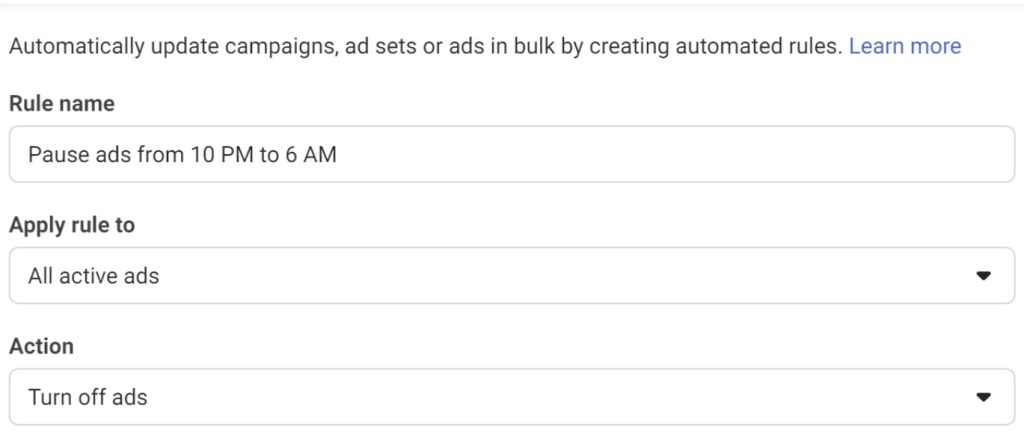
4. Notification Rules
Notification rules send you alerts when specific conditions are met, ensuring you’re always in the loop about your ad performance without having to constantly check. This enables you to act quickly when necessary.
Example: When you set the rule “Send email notification if daily spend exceeds $500.” If your daily ad spend goes over $500, a notification rule will send you an email alert. This allows you to quickly review and adjust your budget as needed, preventing overspending.
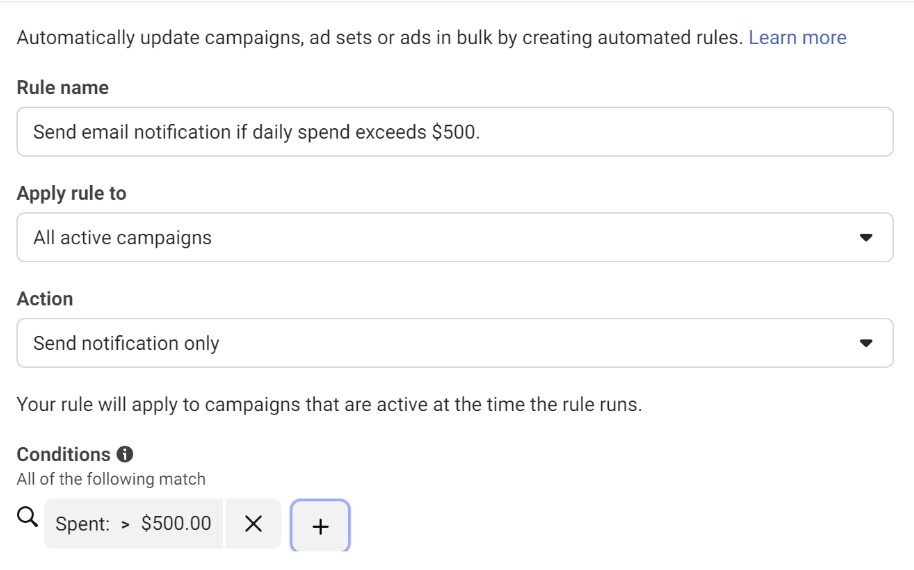
5. Performance Rules
Performance rules automatically adjust various aspects of your ads based on key performance indicators like Click-Through Rate (CTR), Cost Per Acquisition (CPA), or conversions.
Use performance rules to optimize your ads by pausing those that are underperforming or boosting the ones that meet your performance benchmarks.
Example: If an ad’s CTR falls below 0.5% after 1,000 impressions, the rule “Pause ad if CTR < 0.5% after 1,000 impressions” will pause it.
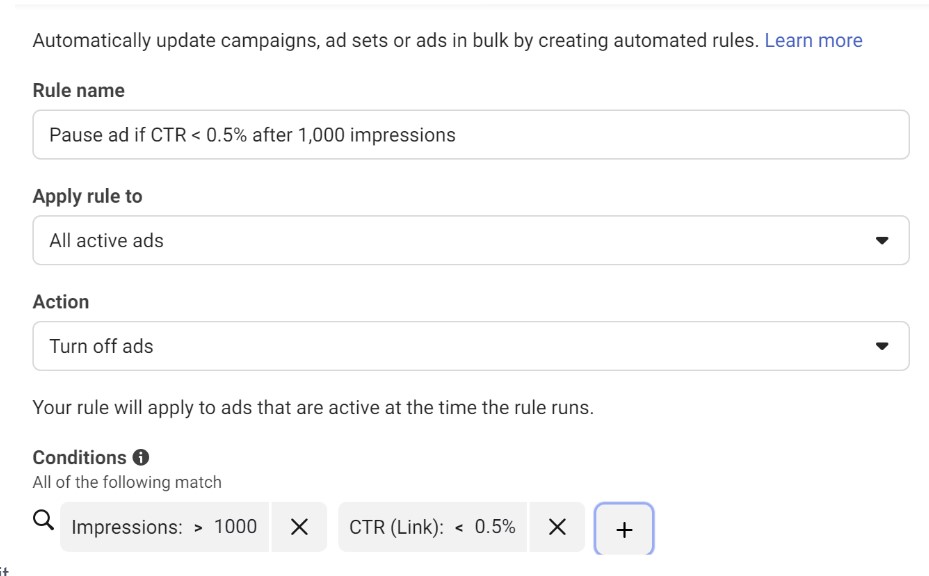
6. Custom Rules
Custom rules offer flexibility by allowing you to combine multiple conditions and actions. This can be particularly useful for complex campaigns with specific needs.
Example: To scale a successful campaign, set a rule “Increase budget by 20% if CPA < $10 and conversions > 50 in the last week” This will ensure that high-performing campaigns receive more resources, driving better results.
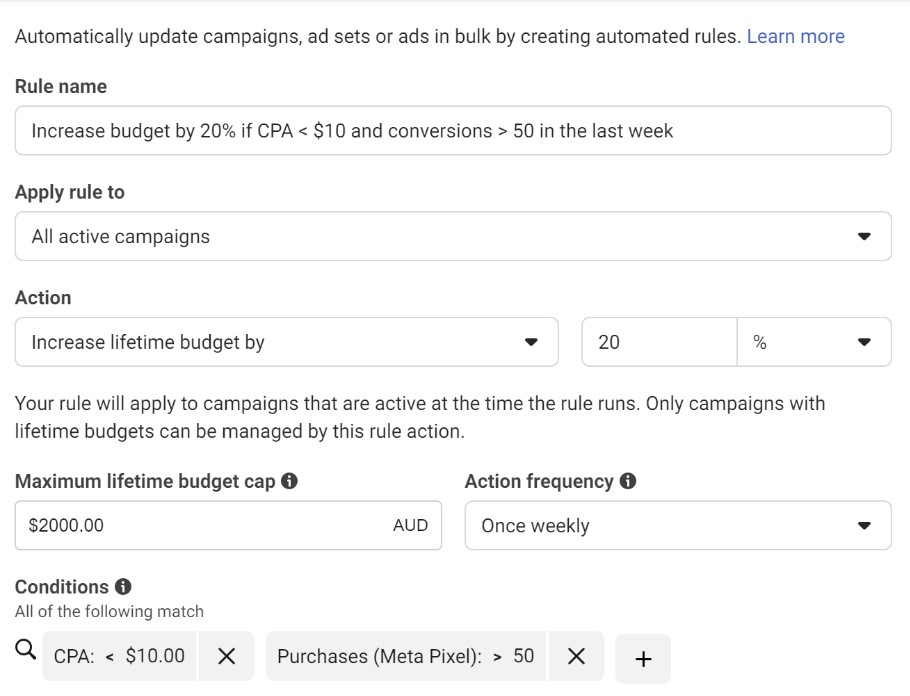
8 Steps to Create Rules for Facebook Ads
Creating rules for Facebook ads is simple and involves setting conditions and actions that Facebook will automatically execute. Here’s a step-by-step guide:
Step 1: Choose “Automated Rules”
- Go to your Facebook Ads Manager dashboard.
- On the left sidebar, click on “Campaigns”
- Under the “Ads Manager” section, click “Automated rules.”
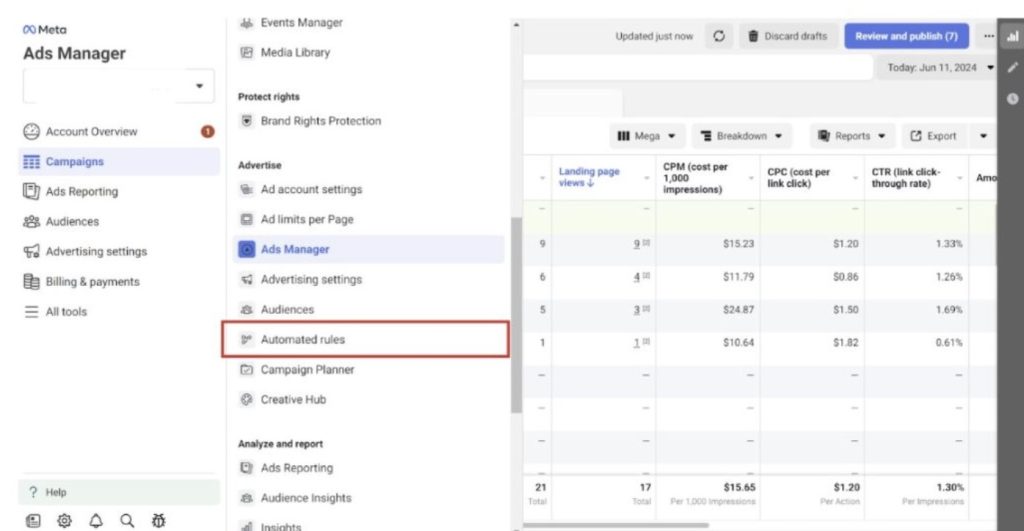
Step 2: Create Rule
On the Automated Rules page, click “Create rule” button.
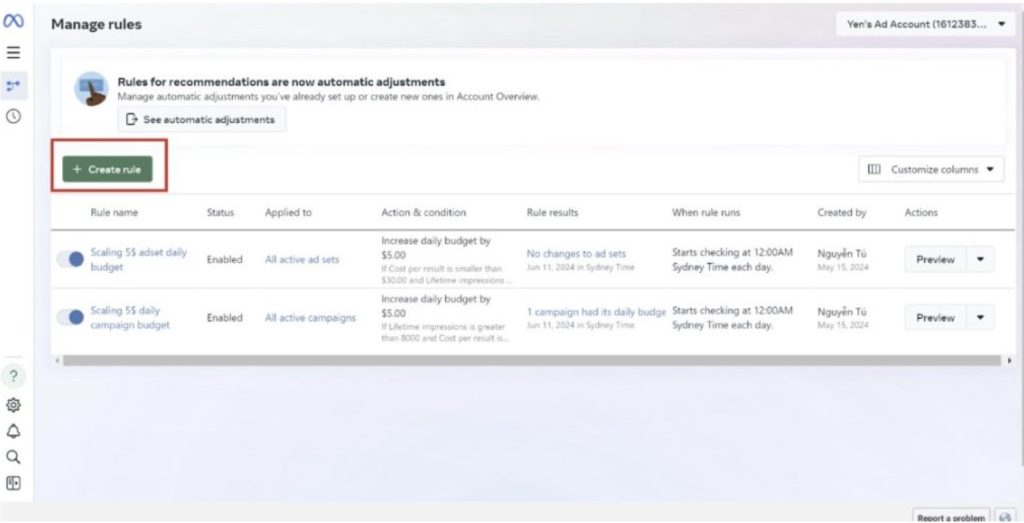
Step 3: Name the rule
You can enter a name for your rule in the section “Rule Name.”
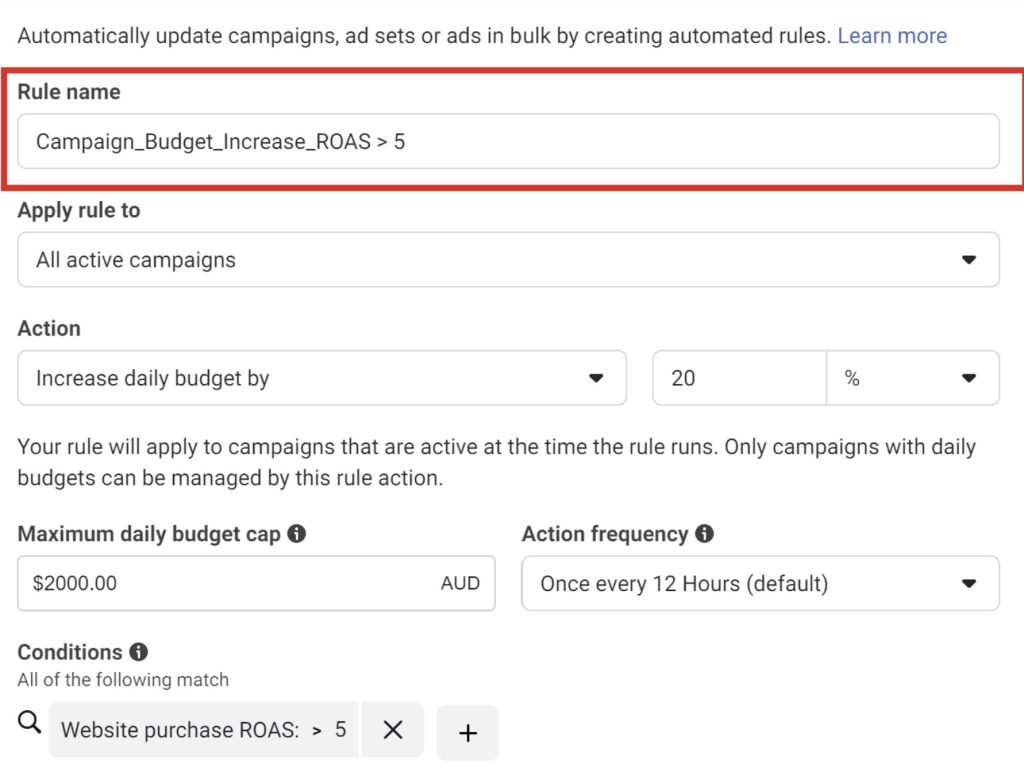
When setting the name for your automated rule, it’s important to choose a name that is clear, descriptive, and easy to understand. Here are some tips for naming your Facebook automated rules:
- Include Relevant Metrics: Use specific metrics like CPC, CTR, ROAS, or CPA in the rule name for clarity.
- Specify the Scope: Clearly state if the rule applies to campaigns, ad sets, or ads. For example, “Campaign_Budget_Increase_ROAS > 5” shows it’s for campaigns and budget adjustments.
Step 4: Choose and apply the rule
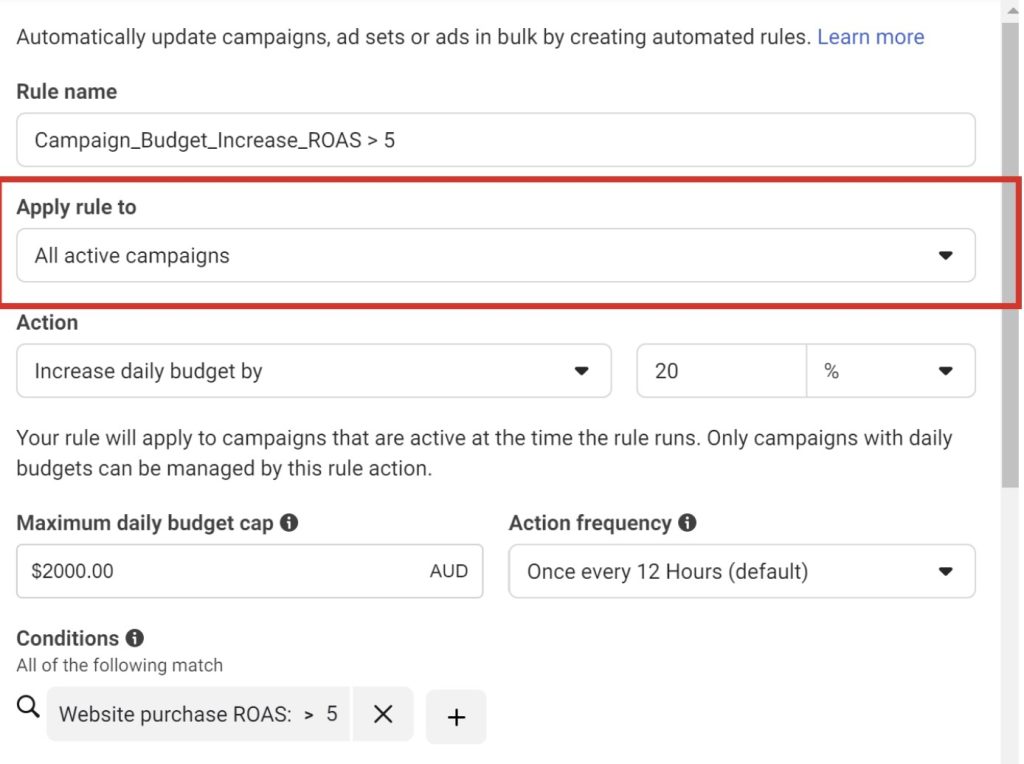
Choose where to apply the rule. Options include “All active ad sets,” “All active campaigns,” or select specific campaigns or ad sets.
- Align Rules with Objectives: Match rules to the campaign’s goals, like applying budget controls at the ad set level.
- Avoid Rule Overlap: Prevent conflicting rules, such as one increasing the budget based on Facebook ads ROAS and another decreasing it based on CPC, to ensure they work together smoothly.
Step 5: Define the action
Defining the action for your Facebook automated rule is a step that determines what happens when the specified conditions are met. This step ensures that your campaigns, ad sets, or ads are managed according to your strategic goals without requiring constant manual oversight. This includes:
- Adjust Budget: Change the allocated amount for a campaign, ad set, or ad to optimize performance based on results or new strategies.
- Adjust Manual Bid: Automatically modify bid amounts for your ads.
- Turn On/Off Ad Sets or Ads: Automatically activate or deactivate ad sets or ads based on set conditions.
- Send Notification Only: Receive alerts when conditions are met, allowing you to manually review and decide on the best action.
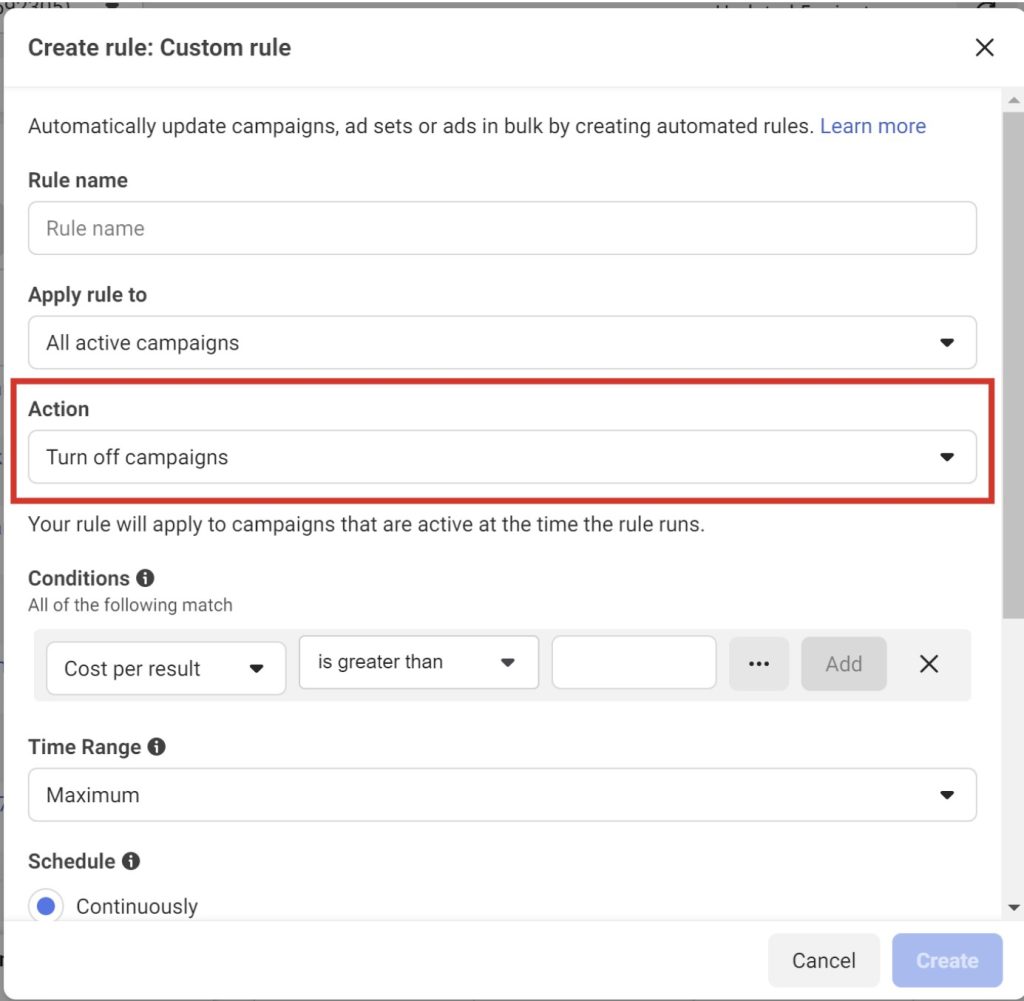
Step 6: Set the condition
You can set conditions by following 2 steps below:
- Click the plus sign to add a condition.
- Choose metrics from the dropdown menu and set it.
Facebook automated rules offer a variety of conditions that you can use to automate the management of your ad campaigns. Common metrics include:
- Impressions
- Clicks
- Click-through Rate (CTR)
- Cost Per Click (CPC)
- Conversions
- Cost Per Action (CPA)
- Return on Ad Spend (ROAS)
- Spend
- Frequency
- Cost Per 1,000 Impressions (CPM)
- Video Views
- Engagement Rate
- Reach
- Page Likes

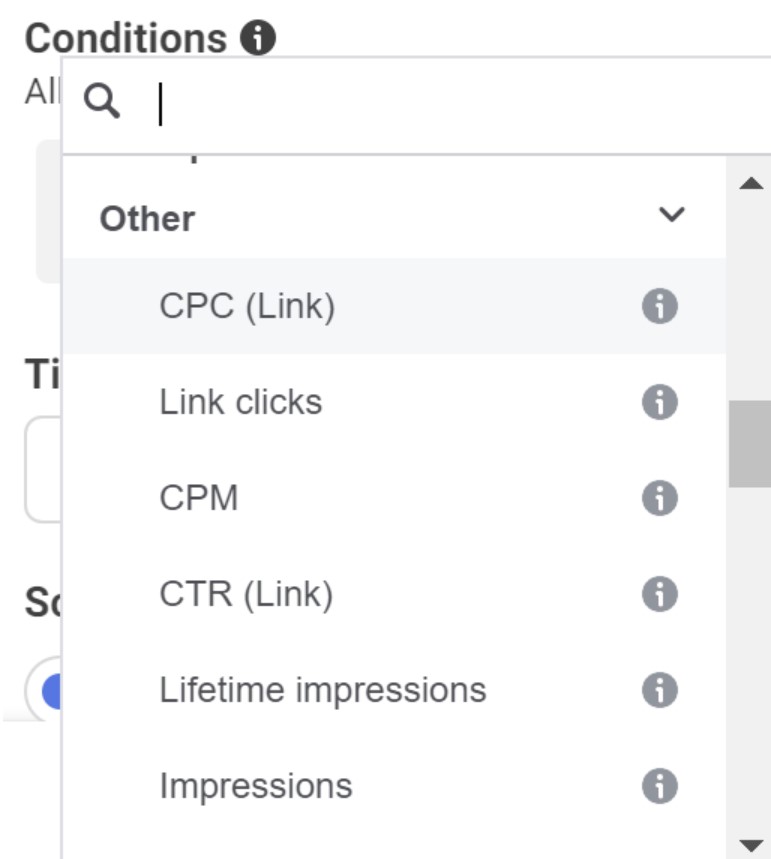
You should ensure that the conditions you set are clear and measurable. Instead of setting a vague condition like “Low performance,” use specific metrics such as “Pause ad set if CPC > $2” or “Increase budget if ROAS > 5.”
Furthermore, for more refined control, you can combine multiple conditions. This helps ensure that the rule is only triggered when all specified criteria are met.
Step 7: Set the time range
Setting the time range for your Facebook automated rules determines the period over which the rule’s conditions are evaluated.
You can typically select from a range of options such as Today, Yesterday, Last 7 Days, Last 14 Days, Last 30 Days, Lifetime, etc.
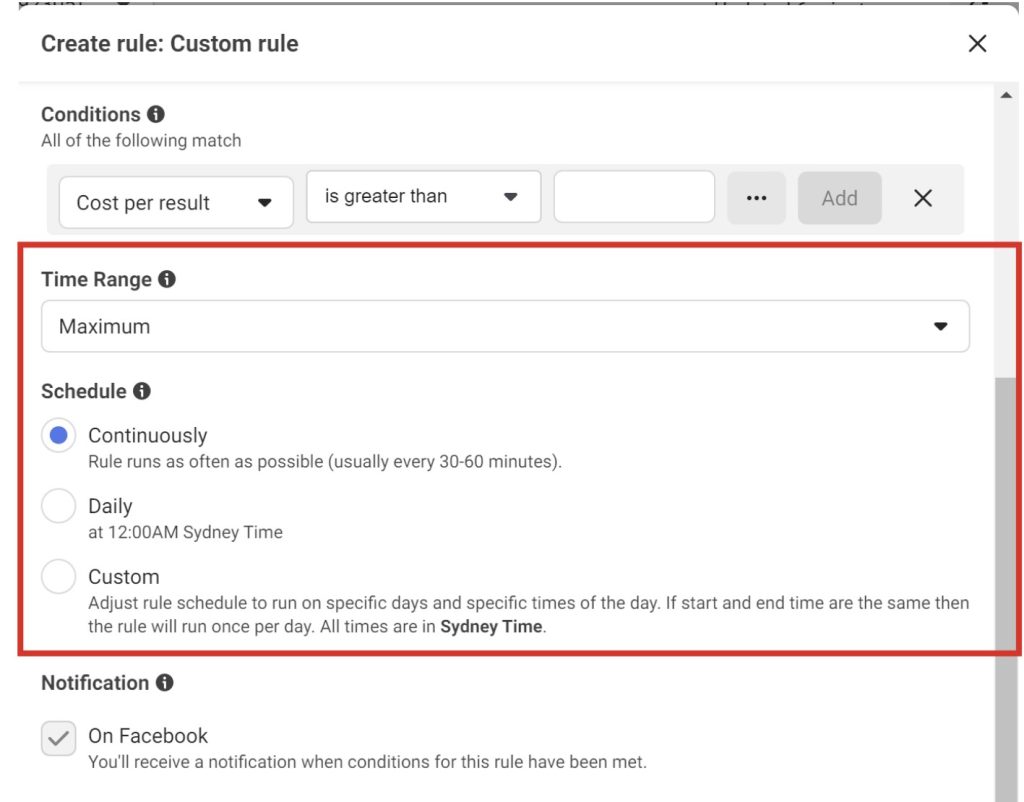
Step 8: Review
- Review the rule settings to ensure they are correct.
- Click the “Create” button to finalize and activate the rule.
If these steps seem time-consuming or difficult, don’t worry. Collaborate with experts to set up and optimize automated rules for peak campaign performance. Mega Digital specializes in managing Facebook ad strategies, leveraging automated rules to maximize ROI. Our clients have seen remarkable improvements, and you can too.
3 Facebook Automated Rules Best Practice
Using Facebook automated rules can greatly enhance the efficiency and effectiveness of your ad campaigns. Here are seven best practices to follow to get the most out of this feature:
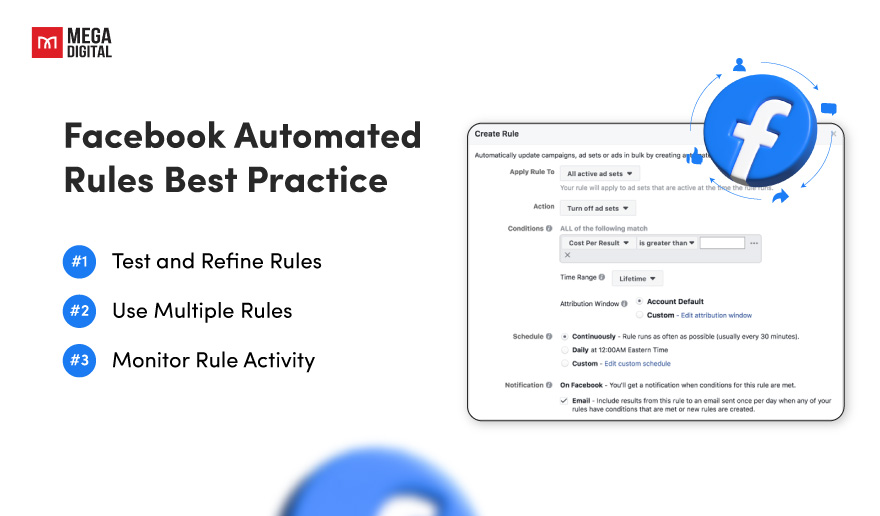
#1. Test and Refine Rules
Continuous testing and refinement ensure that your rules remain effective and aligned with changing campaign dynamics. Use A/B testing to evaluate the impact of different conditions and actions.
For example, adjust the CPC threshold for pausing ads based on observed performance data.
#2. Use Multiple Rules for Different Objectives
Different aspects of your campaign may require different types of rules to optimize effectively. Create specific rules for various objectives such as budget management, performance optimization, and real-time notifications.
For instance, use one rule to increase the budget for high-performing ad sets and another to pause underperforming ads.
#3. Monitor Rule Activity Regularly
Regular monitoring helps you catch any issues early and adjust rules to maintain optimal performance. Check the performance of your automated rules frequently in Ads Manager. Adjust conditions or actions as necessary based on real-time data.
For example. if a rule consistently pauses ads prematurely, you might need to adjust the Facebook ad CTR threshold.
Wrap-up
Using Facebook automated rules can really make a difference in how you manage your ad campaigns. By setting up these rules, you can save time, make sure your ads are always performing well, and quickly respond to any changes. Whether it’s adjusting your budget, managing bids, or getting notifications, these rules help you keep everything running smoothly.







